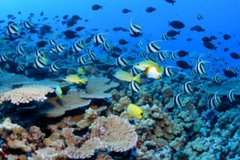Underwater video of low dissolved oxygen event in Hood Canal
Over the past several years, low-oxygen events in Puget Sound's Hood Canal have caused significant die offs of marine life, including multiple species of fish, shellfish and invertebrates. While low-oxygen levels are not new, these low-dissolved oxygen events have become more frequent and longer lasting in recent years.
Hood Canal is an underwater fjord where normal oxygen exchange in the water takes place slowly because of the depth of the water and the canal's shape. Nitrogen entering the water from human sources stimulates algae blooms in the canal. When algae decomposes, it absorbs oxygen from the water. Under certain weather and wind conditions, the level of life-sustaining dissolved oxygen in the water drops so low that fish and other underwater species suffocate.
Parts of Hood Canal are prime habitat for slow-reproducing species, such as rockfish and lingcod. These fish are most susceptible to low-oxygen events because they normally live as long as 25 years before reproducing offspring.
The Washington Department of Fish and Wildlife (WDFW) filmed underwater conditions in Hood Canal during a Sept. 19, 2006, low-oxygen event. This underwater video was filmed near Sund Rocks on the west side of Hood Canal by WDFW Research Scientist Wayne Palsson.
WDFW is monitoring conditions in Hood Canal and is working to improve and restore Puget Sound's habitat as a sponsor of the Puget Sound Nearshore Partnership and an active participant in Gov. Christine Gregoire's Puget Sound Initiative.






































